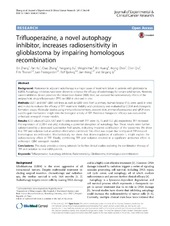| dc.contributor.author | Zhang, Xin | en_US |
| dc.contributor.author | Xu, Ran | en_US |
| dc.contributor.author | Zhang, Chao | en_US |
| dc.contributor.author | Xu, Yangyang | en_US |
| dc.contributor.author | Han, Mingzhi | en_US |
| dc.contributor.author | Huang, Bin | en_US |
| dc.contributor.author | Chen, Anjing | en_US |
| dc.contributor.author | Qiu, Chen | en_US |
| dc.contributor.author | Thorsen, Frits | en_US |
| dc.contributor.author | Prestegarden, Lars | en_US |
| dc.contributor.author | Bjerkvig, Rolf | en_US |
| dc.contributor.author | Wang, Jian | en_US |
| dc.contributor.author | Li, Xingang | en_US |
| dc.date.accessioned | 2018-03-21T13:27:13Z | |
| dc.date.available | 2018-03-21T13:27:13Z | |
| dc.date.issued | 2017-09-05 | |
| dc.Published | Zhang X, Xu R, Zhang C, Xu, Han, Huang B, Chen A, Qiu, Thorsen F, Prestegarden L, Bjerkvig R, Wang J, Li X. Trifluoperazine, a novel autophagy inhibitor, increases radiosensitivity in glioblastoma by impairing homologous recombination. Journal of Experimental & Clinical Cancer Research. 2017;36:118 | eng |
| dc.identifier.issn | 1756-9966 | |
| dc.identifier.uri | https://hdl.handle.net/1956/17541 | |
| dc.description.abstract | Background: Resistance to adjuvant radiotherapy is a major cause of treatment failure in patients with glioblastoma (GBM). Autophagy inhibitors have been shown to enhance the efficacy of radiotherapy for certain solid tumors. However, current inhibitors do not penetrate the blood-brain-barrier (BBB). Here, we assessed the radiosensitivity effects of the antipsychotic drug trifluoperazine (TFP) on GBM in vitro and in vivo. Methods: U251 and U87 GBM cell lines as well as GBM cells from a primary human biopsy (P3), were used in vitro and in vivo to evaluate the efficacy of TFP treatment. Viability and cytotoxicity was evaluated by CCK-8 and clonogenic formation assays. Molecular studies using immunohistochemistry, western blots, immunofluorescence and qPCR were used to gain mechanistic insight into the biological activity of TFP. Preclinical therapeutic efficacy was evaluated in orthotopic xenograft mouse models. Results: IC50 values of U251, U87 and P3 cells treated with TFP were 16, 15 and 15.5 μM, respectively. TFP increased the expression of LC3B-II and p62, indicating a potential disruption of autophagy flux. These results were further substantiated by a decreased Lysotracker Red uptake, indicating impaired acidification of the lysosomes. We show that TFP and radiation had an additive effect when combined. This effect was in part due to impaired TFP-induced homologous recombination. Mechanistically we show that down-regulation of cathepsin L might explain the radiosensitivity effect of TFP. Finally, combining TFP and radiation resulted in a significant antitumor effect in orthotopic GBM xenograft models. Conclusions: This study provides a strong rationale for further clinical studies exploring the combination therapy of TFP and radiation to treat GBM patients. | en_US |
| dc.language.iso | eng | eng |
| dc.publisher | BioMed Central | eng |
| dc.rights | Attribution CC BY | eng |
| dc.rights.uri | http://creativecommons.org/licenses/by/4.0 | eng |
| dc.subject | Trifluoperazine | eng |
| dc.subject | Autophagy inhibitor | eng |
| dc.subject | Radiosensitivity | eng |
| dc.subject | Glioblastoma | eng |
| dc.subject | Homologous recombination | eng |
| dc.title | Trifluoperazine, a novel autophagy inhibitor, increases radiosensitivity in glioblastoma by impairing homologous recombination | en_US |
| dc.type | Peer reviewed | |
| dc.type | Journal article | |
| dc.date.updated | 2018-01-05T09:53:52Z | |
| dc.description.version | publishedVersion | en_US |
| dc.rights.holder | Copyright 2017 The Author(s) | |
| dc.identifier.doi | https://doi.org/10.1186/s13046-017-0588-z | |
| dc.identifier.cristin | 1507736 | |
| dc.source.journal | Journal of Experimental & Clinical Cancer Research | |

